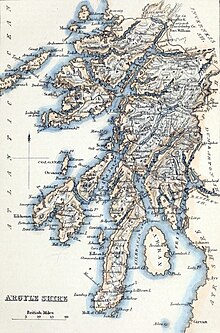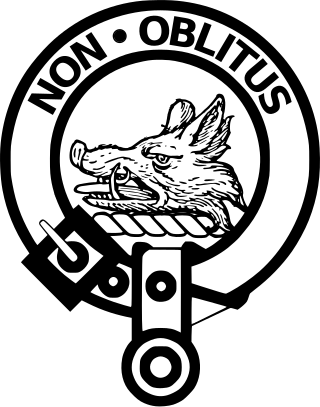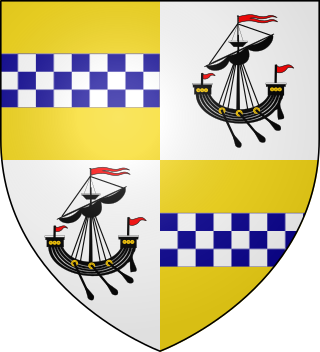Contents
In addition to a foreword by John Campbell, 9th Duke of Argyll, and an introduction by the Rev. John Mackechnie, The Dewar Manuscripts Vol.1 contains 45 of the folktales translated from John Dewar's original notes in Gaelic. [4]
Folktales
- Cailean Mór
This story describes an assassination attempt on Cailean Mór (Big Colin) by the Malcolm Clan. Cailean Mor escapes his attackers by ditching his shirt of mail in a pool, giving the pool its name of Linne na Lurich, 'Pool of the Mailshirt'.
- Macarthur and Campbell
MacCailen Mor of the Campbells tricks the laird of Strachur into giving up the chief seat at the meeting of the Argyllshire gentry.
- The Macfies and Auchry Malcolm
Great warrior of the Malcolm Clan, Big Auchry, makes a brave last stand against the Macfies of Colonsay in his mountain hold.
- Macvicar of Dail-Chruinneachd and Mackellar of Mam
A son of Clan Vicar and a daughter of the Mackellars are joined in an extravagant wedding celebration. A fight at the wedding leads to the exile of Angus Mackellar of Kilblaan and the eventual addition of the land of Kilblaan into the land of Argyll.
- The Mackellars of Mam
The laird of Glendaruel dreams that his thumb and small fingers switch place. An old woman tell him that his youngest son will be laird rather than his eldest. This comes to pass.
- Elegy to the son of Neil Mackellar of Mam
- Sir Neil Campbell and the Lamonts
The widow of the baron MacLachlan is harassed by men of the Lamonts, who steal her corn. Sir Neil Campbell sends his army commanded by Mannach of the Big Boots to punish the Lamonts. Fighting ensues, the Lamonts eventually being forced out of Cowal.
- The First Duke John
Multiple tales featuring Duke John of Argyll.

- Elegy to Sir Neil Campbell of Eilean Dearg
- Sir John Campbell of Eilean Dearg
Sir John Campbell inherits the Island of Dearg in Loch Riddon. He is imprisoned for debt and sells the Island to Colonel Campbell.
- Lochiel and the Duke of Athol
Locheil and the Duke of Athol meet to negotiate ownership of the land of Aird-raineach.
- Traditions of Arrochar
Tales of the theft and recovery of cattle in the region of Arrochar.
- The daughter of Duncan Campbell of the Braes
A woman descended from the Braes convinces a band of cattle raiders to return her livestock.
- Mischievous Duncan
Duncan Macfarlane burns down some hunting booths, while plundering Athol-men lay asleep inside them.
- The last attempt to carry off a spoil from Arrochar
Men from Sunart learn of the wealth of James Turner in Glen Loin, and plan to rob his house. The inhabitants of the house, along with an old soldier turned beggar, defend the house long enough for the Minister of Arrochar to assemble a host and chase off the Sunart-men.
- The descendants of the Piebald Horse
The heir of the Macfarlanes in Arrochar is tricked by his step-mother into giving up his inheritance.
- Macfarlane of Arrochar and the Laird of Luss
Macfarlane of Arrochar and his men kill Sir Humphrey, the laird of Luss. Macfarlane removes the iron gates of Ros Dubh as proof of his victory over Luss.
- Clan Nail
The men of Clan Nail become involved in a bloody fight with one-another without knowing why. From then on Clan Nail is used to describe people who were once great friends but then hated each other.
- Big Malcolm Macilvain
A series of tales following Big Malcolm MacIlvain, a swordsman and adventure of the Ilvain clan.
- Big John, grandson to Big Malcolm MacIlvain
Big John demonstrates his strength by beating his son and servant in a wrestling contest.
- Rob an Roibein (Robert Campbell) MacCailein's Forester in Cowal
King James sends men to take the land charters of MacCailein Mor from the forester Rob an Robein. The story is left unfinished.
- The Macleans of the white-faced Horse
A tale describing how there came to be a family of Macleans living in Cowal
- The Great strait of the Feinn
The men of the Feinn, commanded by Fionn MacCumhail, fight a series of battles against the army of the King of Lochlann, Earragan.
- Charles Stuart of Ardsheil
A long account of Charles Stuart, the laird of Ardsheil, and his role as colonel of the army of Prince Charles.
- The laird of Invernahyle
The household of the laird of Invernahyle work together to prevent the King's soldiers from capturing the laird.
- The Maccolls of Ben Vair
Following the death of Ian Glas Stewart, at the battle of Culloden, his relatives the Maccolls take the best of his cattle to prevent them from being taken by the King.
- Cameron of Fassifern
The rebel, Lochiel of Fassifern is expected to be disinherited and forced to flee the country. His brother, Cameron of Fassifern, forges a land charter to secure a portion of Locheil's land for himself.
- Barcaldine
The lady of Barcaldine tricks her servants into eating dog meat, to stop them from stealing food.
- Colin of Glenure
An account of the management of the lands of Lochiel and of Stewar of Appin, under the factorship of Colin of Glenure.
- James Stewart of the Glen
John Stewart treats the Duke of Argyll to great hospitality and earns his leave to take down James Stewart's body from the gallows.
- Allan Breck Stewart
Allan Stewart sends a letter from abroad, falsely confessing to the murder of Colin of Glenure. He admits this to a group of captured Scots soldiers captured by the French army, whom he helps escape.
- Donald Stewart
The brother of Colin of Glenure notices that Donald Stewart's gun leaves the same bullet pattern as that which killed Colin. The two men quarrel and the people of Ballachulish treat the gun with suspicion.
- The Family of Ardsheil
Duncan Stewart returns to Scotland and recovers the lease of Ardsheil.
- Big Duncan Mackenzie
A son of the Mackenzie clan makes a name for himself by splitting open an Englishman's head at the battle of Prestonpans. He is later captured and made to swear to fight for Prince Charles no longer.
- The Battle of Gladsmuir (Prestonpans)
Accounts of various events which took place during and following the battle of Prestonpans.
- Four soldiers killed by Big Duncan Mackenzie and the smith of Ballachulish, Lochaber
Duncan Mackenzie and the smith of Ballachulish fight and kill four soldiers who are harassing a woman.
- The Battle of Culloden
Accounts of various events which took place during and following the battle of Culloden.
- Big Archibald MacPhail
A series of stories from the life of Big Archibald MacPhail, a powerful but reckless adventurer.
- Young John Maccoll of Larach
Stories relating to the ancestors of John Maccol of Larach.
- Gillespie MacCombie
Stories told by Gillespie MacCombie relating to his ancestors.
- The MacGillivrays
How the descendants of Gille-bràigh became known as the MacGillivrays.
- Kinlochbeg
The laird of Callart and the laird of Kinlochbeg quarrel over the right to fish on the river Lee.
- The Stewarts of Appin and the MacDonalds of Glencoe
The MacDonalds of Glencoe are defeated in battle and their heads are cut off. A cairn called the 'Cairn of the Heads' is raised at the site of their beheading.
- Little John MacAndrew
A small man living in the land of the Grants develops a reputation as an excellent archer. Many men of the MacDonalds of Keppoch attempt to kill John MacAndrew, but none are able. The Grants send a party of men to attack the Keppoch-men, but all are killed.
- MacArthur of Barra Nan Lion and MacKellar of Cruachan
MacKellar of Cruachan holds the right to primae noctis over MacArthur's daughter. MacArthur asks MacKellar to give up this right but is denied. MacArthur and his sons kill MacKellar and flee across the country. The descendants of the four sons prosper, but the descendants of MacKellar are unfortunate.
















